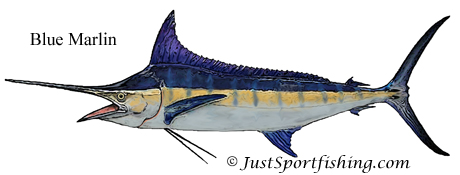|
|

How
to fish for Blue Marlin
When on the hunt for Blue Marlin fish over known pinnacles, sea mounts and ridges. These structures are where bait are known to inhabit, especially the Skipjack Tuna a favorite in the diet of Blue Marlin. These tuna usually hang around these structures, because of the upsweep of the currents below. The currents bring up squid, baitfish, and shrimp that the skipjack feed on.
To Rig up a Skipjack Tuna to troll live use rigging floss and insert a bait needle through the top of the eye socket. This is called bridling the bait. Then twist the hook a few times to take up the slack in the floss. When completed your hook should be tight above the eyes of the bait.
We use 300 Lb. test fluorocarbon leader with a 16/0 or 20/0 circle hook depending on the size of the bait used. A typical rod set up for Blue Marlin fishing is a 80 Lb. class rod , with a 50 wide reel spooled with 80 Lb test clear line. Fish several rods at a time for better chances of hooking up on a Blue Marlin.
When fishing Blue Marlin using live tuna, adjust the boat speed so the tuna swims along effortlessly and looks natural. When over the structure put the boat into neutral and this allows the baits to swim down deeper. This method seems to produce more bites from Blue Marlin. If we have no luck the boat is put into gear to move on down the structure.
When there are no known pinnacles, sea mounts and or ridges and you are in deep blue water look for bird activity such as feeding, diving , or circling. This activity usually means bait, where schools of Skipjack tuna and Yellowfin tuna are feeding. Use tunas from 10 Lb to 20 Lb for bait. The method used in open water fishing for Blue Marlin when using live tunas for bait is to troll the tunas on the outer edge of the schooling tunas. The Blue Marlin usually stay on the outer edge of the tuna and dart into the school for there prey.
If the live bait just isn't working for you try lures. The following are some that may produce well, Moldcraft Wide Range in blue/pink/white, Moldcraft Super Chugger in black/orange, Pakula Cockroach, Black Bart Super Plunger, or Coontail in black/red. You should probably pull all these lures on 80 to 130 pound test, but the Coontail is small enough for 50 pound test. When trolling lures boat speed is key. Speed for lures typically ranges from 7 1/2 to 9 knots, but its more important how the lure acts than specific boat speed. Lure fishing isn't as simple as many people think. It takes more effort to keep lures working properly at slow speeds than high speeds. Blue Marlin that come up behind a lure and track it while showing little interest before returning to the depths means you're probably trolling too slowly. Blue Marlin fishing lures should pop and the more froth the better.

|
JustSportfishing.com

|


